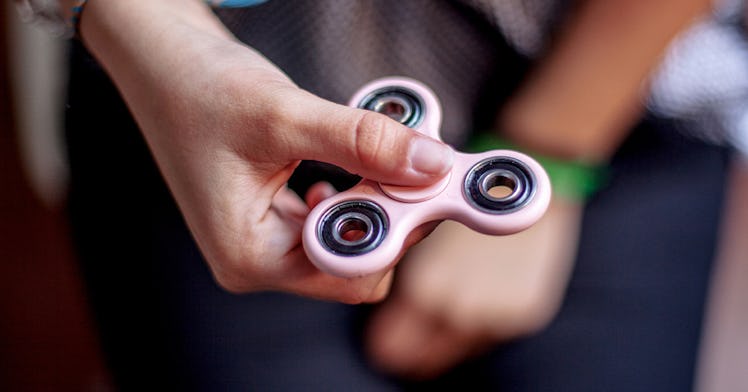How Do Fidget Spinners Work? Fidget Spinner Physics, Explained
"Nice angular velocity, son, but you need to work on that high negative angular acceleration."

Handheld three-pronged gadgets that, with a flick of the wrist, absently twirl between your fingers, fidget spinners are well on their way to becoming the top low-tech toy of 2017. Since the fidget spinner craze took off, manufacturers have made millions (of toys and dollars), schools have banned the palm-sized windmills, and psychologists have declared the gadgets potentially therapeutic. But how do fidget spinners work, and, most importantly, how can you make them spin longer and faster? Enter physics—your high school nightmare, and your key to fidget spinner nirvana.
What Is A Fidget Spinner?
Fidget spinners are essentially low-friction ball bearings. That’s it.
When two objects press against one another, friction prevents them from sliding smoothly. If you try to slide a block of wood across a wooden floor, you’ll find that it eventually stops sliding thanks to the friction between these two objects. But if you roll a wooden ball across that same floor, even though wood is still meeting wood, the ball meanders along as friction takes a vacation. That’s because rolling friction (a misnomer) is far weaker than run-of-the-mill sliding friction, because the surface of contact between the ball and the floor is relatively insignificant.
Ball bearings take advantage of this neat physics trick to create incredibly low-friction surfaces. Jet engine shafts, watch movements, and skateboard wheels all have been known to feature ball bearings of various grades and friction coefficients.
Most fidget spinners have a ball bearing right in the center of the toy, which is what you’re holding as it spins. The center consists of several tiny balls sandwiched between two circular channels called the “inner race” and the “outer race.” Without the balls, the races would spin against each other for only a few moments, until sliding friction declared victory. But, thanks to the balls between their surfaces, the races can spin for far longer, subject only to rolling friction.
How Can I Make My Fidget Spinner Go Longer?
The short answer is this: with a frictionless surface. Unfortunately, without superliquid Helium or some nanotech know-how, you’re unlikely to be able to pull that off for your fidgeting needs.
So we’re left with strategies for reducing friction within the ball bearing. One easy way is the lubricate the bearing and clean out dirt that may increase friction between the races. If you’re designing your own Fidget spinner, consider less conventional materials. The friction that exists between ceramic and steel, for instance, is far less than steel on steel. Which means that two steel races spinning about ceramic balls could seriously upgrade your fidgeting game.
How Long Can I Keep My Fidget Spinner Spinning?
That depends on angular velocity that you started out with, Rhett Allain, a professor of physics at Southeastern Louisiana University, writes in WIRED. Allain placed his own fidget spinner (nobody is safe) under a laser to calculate the rate of change in angular position over time (sort of like figuring out the speed you’re driving by calculating how many miles you cover per hour). Since the spinner slows down over time, Allain also had to calculate the angular acceleration, or the fairly constant rate at which the Fidget spinner slows toward the inevitable.
The angular acceleration (α) can also be calculated by dividing the change in angular velocity (Δ⍵) by the change in time (Δt) which sounds tricky, but it’s essentially the same as telling a driver to calculate his or her acceleration by dividing the car’s current speed by what it was one minute ago. A little bit of elbow grease and mathematics yields this handy equation:
α = Δ⍵ / Δt
Now, thanks to Allain’s laser, we know that a good spin can get us a angular velocity of about 140 radians per second at an angular acceleration of about -1.346 radians per second (the acceleration is negative because the Fidget spinner is slowing down, or decelerating). Plug in those numbers and you’ll find that Δt= 104.011. That’s 104 seconds of glorious spin time.
Admittedly, without a laser, industrial grade materials, and a physicist, it might be tricky to test any of these ideas out on your own. But it’s guaranteed to make you a hit around your kids. Nice angular velocity, son, but you need to work on that high negative angular acceleration.
Works every time.
This article was originally published on